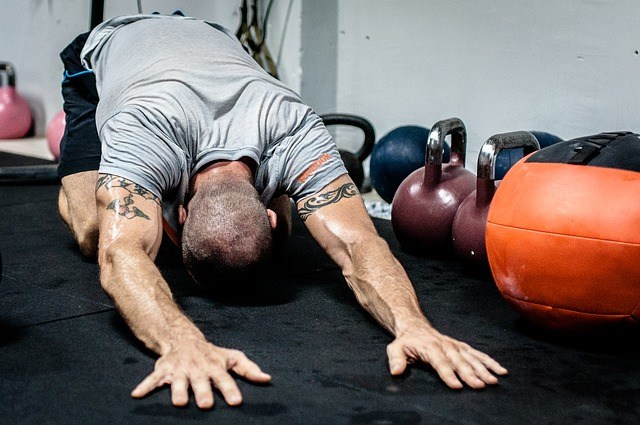
If you break your leg, it’s easy to see the path to recovery. I’m not saying the process is easy, but you have the knowledge that you’ll be in a cast for a certain amount of time, you’ll do rehab, and you’ll slowly get back to normal activities.
Getting back to normal isn’t quite as easy with issues you cannot directly see. Things like a viral cold, flu, infection, or a stressful period of life can wipe out your body’s reserves.
Through my years as a coach, I’ve observed that one of the most difficult things to judge is when to get back to full-go activities after being down and out for a period. You may feel fine but jumping back into a workout routine or sport too quickly can set you back.
If you think about your energy reserves as a gas tank, you may have enough to keep going for a little while, but you’ll run out quickly. This is even more apparent after the fact — like when you wake up the next day and have no energy. Lacking energy and drive can not only set back your performance goals, but your daily tasks as well. I found this lesson out the hard way.
My Less-Than-Successful Comeback Story
About four years ago, I was supposed to be in Costa Rica, enjoying a trip with friends and colleagues. The month before the trip, I couldn’t get through a day without a nap, felt like I had blood pressure and blood sugar issues, had joint pain with workouts, and generally had no energy. Somehow, I didn’t think much of it and I went to the airport for my trip.

At midnight, my flight was boarding. The woman checking tickets looked at my passport, shook her head, and pulled me aside. Apparently, it was too wrinkly, and she said I couldn’t get on the plane. We were in Denver connecting from my home in Salt Lake City, so I would have to wait to fly back home until the next day.
The stress of the travel and that night away did me in.
I woke up in my hotel bed freezing, even though it was summer. I sat on the plane in my hoodie, yet was shivering and sweating. The poor man next to me on the plane watched as I drank two cans of juice in thirty seconds. I ended up in the hospital, diagnosed with an intestinal infection. The doctors gave me some strong antibiotics and sent me on my way.
You would think I would have learned at this point.
But, no — instead of Costa Rica, my wife and I figured we would just drive to Glacier National Park for a relaxing week and day-time hikes. But for each mile I hiked, I had to nap about an hour. I took it in stride — I figured that would last for a week or so until everything cleared up.
I was very wrong.
It took me almost eight months to declare myself fully recovered. Months after the infection, my workouts were still no more than a warmup for most people. I would do some balance exercises, arm circles, and light band work. The wave of fatigue after about fifteen minutes was overwhelming. This infection kicked my butt, and it took a very long time for my body to build its reserve energy back.

What I Do Differently Now
Since that time, I’ve been sensitive about observing people I work with. After family stress, lack of sleep for a time, illness requiring antibiotics, migraines, and anything similar, there needs to be a plan of action for healing.
This is especially true for the active person who can’t stand rest days. I’ve noticed that people who jump back to normal activity right away often experience setbacks. These people may feel great in the moment and have a killer workout, hike, or ski weekend, but then experience rebound illness, fatigue, or other reoccurring problems.
I believe the problem is that these people were teetering on the edge of recovery — and taking on too much too soon pushed them backward.
As I said in the beginning, these situations are understandably difficult because we cannot directly see our problem. To that end, I have developed strategies to help people navigate these mysterious waters.
Timelines and Intensity
I generally use a 1:2 ratio for creating a timeline. If you had an illness or other issues for a week, then take a minimum of two full weeks of slowly easing yourself back to your normal fitness routine.
This ratio is, of course, dependent on the severity of what’s going on with you. For a general cold or bad week, two weeks should be a fine recovery period. For a more serious illness, the ratio should be higher and the recovery period longer.
What do I mean by “easing” back into your exercise? My suggestion is to begin like this, assuming we are aiming for the two-week mark:
Week 1
Your first workout, whether it be strength or endurance, will be about 40% effort. If we are talking strength training, cut the weight you normally use by 50 to 60%, and also do one to two fewer sets than normal. Increase your rest intervals as needed, and spend some extra time warming up and cooling down. If you are doing an endurance activity like running, reduce the mileage by the same 50-60%, and also pace yourself as if it were just a warm-up session.
In addition, take at least one day off between workouts. The biggest thing to monitor is your energy levels and soreness after each workout, and also the day after. Sometimes things don’t hit you until the next day. So, if you end up dragging your feet the day following a training session, then stick with the same intensity you did for the first workout or even dial it down a bit.

If you feel relatively good after a day of rest, increase your intensity by about 10% and slowly pick up the pace. By the end of the first week, you should be at 50 to 70% effort, with recovery becoming easier each time.
If your recovery is not coming easier, then remain where you are and repeat the same workout. If you find yourself going in reverse, take it even easier and block out some time to just stretch, meditate, and do warmup activities — but nothing more.
Either way, take the weekend to relax.
Week 2
As long as you are feeling good, continue to ramp things up by about 10% each workout, with a day of rest in between. By the end of the week, you should be at about 95% effort, so almost normal, but hold back a tiny bit. Take the weekend off to see how well you recover. If all is well, and your energy levels remain high and soreness levels low, it would be relatively safe to resume normal activity at the start of week three.
I gave a two-week example here, but obviously the recovery period can go much longer. A good rule of thumb is that the longer the recovery time is projected to be, the slower you should advance your intensity. This means that instead of jumping intensity by 10% each workout, go by 5% or less.
While you’re working through this period, it may almost feel like you are doing the same workout each time, but you’ll be making small advances — like an extra rep or walking a little extra after a run — don’t shortchange yourself for these gains. You’re doing it right.

Nutrition and Lifestyle
There are some considerations in respect to food and relaxation that may accelerate your progress. The most obvious are eating a healthy diet and getting plenty of rest. Let’s dive into some details on those topics.
Recovery is probably not the best time to start a weight-loss program or start toward any other goal relating to body composition. We want to give the body what it needs to build up its reserve energy. To that point, I advise to eat at weight maintenance level. While it would make sense to perhaps eat a few extra calories to help recover, your toned-down activity level will make up for that. Simply put, there will be extra calories available for rebuilding with normal eating.
Your big focus should be on whole foods. Make an effort to get an extra serving of vegetables at dinner and add fruit for desert. Avoid foods you know don’t agree with you and stick to nutrient-dense ones. All these things are quite basic, but recovery requires an extra focus on the basics.
Hydration is especially important. Aim for half of your body weight in ounces of pure water. So, if you weigh 150 pounds, shoot for a minimum of 75 ounces of water each day. Eating more fruits and vegetables will help with hydration as well, but don’t count anything but water with the half bodyweight rule. Being hydrated — or, even more importantly, not being dehydrated — will help all your organs and bodily functions return to operating at optimum levels.

Be sure to find time for sleep between chowing down. Get the basic advice of seven to nine hours per night. While you’re sick and during recovery, you may notice an urge to nap. If you can find it in your schedule, try to close your eyes for an extra fifteen minutes during the day. Listen to your body.
If you have trouble falling asleep, turn off the computer and phone screens an hour early, read a book or meditate, and dim the lights starting after dinnertime. All the planned workouts, healthy food, and water will only help you if you give yourself enough time to sleep and relax.
You Can Call It a Comeback
Getting back to action after an illness or stress can be a genuine challenge. It’s normal for us to want to get back to “normal” right away. But as a coach, I’ve seen way too many setbacks with people rushing back into the fray. I’d much rather have you take an extra few slower weeks in the short term to ensure you return to a healthy, happy, energetic long-term outlook.
It took me a bad experience to learn this lesson. And while certainly every person or situation is different, you really can’t go wrong by leaning to the conservative side when it comes to building yourself back up. Trust me.
Listen to your body, be more careful than you want, and before that long you’ll be one-hundred percent again.



































